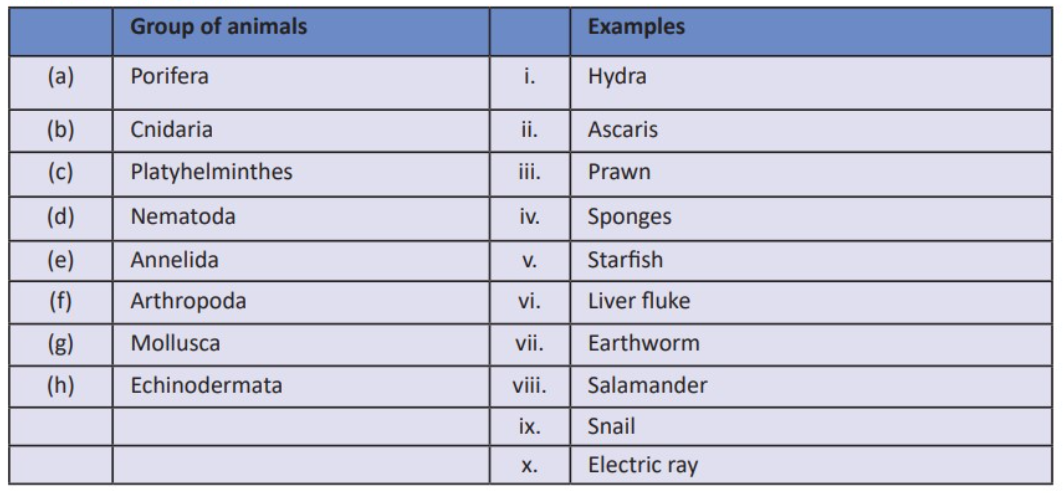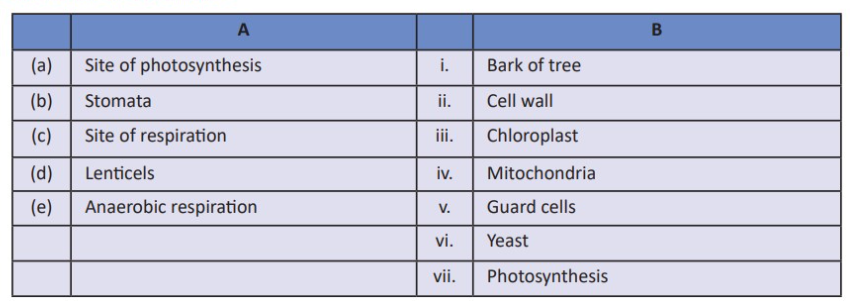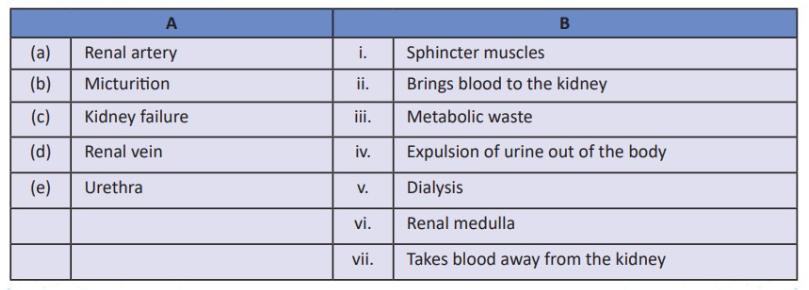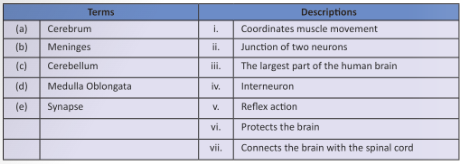Question bank
Chapter-1 Tissues
Q-1 Fill in the blanks .
(1) Phloem is responsible for transportation of ____________
(2) A conducting tissue in plants is _____________
(3) A tissue that carries gases and nutrients _____________
(4) A tissue that transports food in plants _____________
(5) A tissue that conducts messages in animals _____________
(6) The fluid matrix of blood _____________
(7) Cuboidal epithelial cells are found in _____________
(8) Lymph is a _____________ coloured liquid.
(9) Striated muscles have _____________ nucleus.
(10) The thin elongated part of a nerve cell is called _____________
Q-2 Match the following

Q-3 State True or False and correct the false statements
(1) In meristematic tissue the cells are living
(2) Xylem is a meristematic tissue.
(3) Permanent tissue is made of dividing cells
(4) Lateral meristem are responsible for increase in girth of plants.
(5) Sclerenchyma is found in seed coat.
(6) Phloem is a dead permanent tissue.
(7) Ciliated epithelium is found in salivary glands.
(8) Ligaments join muscles to the bones.
(9) Areolar tissues can be found beneath the skin
(10) The matrix in cartilage is semi-solid.
Q-4 Short answer type questions
(1) What is a tissue?
(2)Where do we find meristematic tissue?
(3) Name a fluid connective tissue and its one function.
(4) What is the usefulness of xylem tissue?
(5) What is aerenchyma?
(6) What is the function of columnar epithelial cells in the intestine?
(7) Explain the movement of materials in phloem tissue.
(8) Enumerate two functions of adipose tissue.
(9) What is an important feature of cardiac muscles?
(10) What kind of tissue is cartilage?
Q-5 Long answer type questions
(1) What are the important characteristics of meristematic tissue?
(2) What are the main characteristics of permanent tissues in plants?
(3) How is permanent tissue different from meristematic tissue?
(4) Differentiate between parenchyma, collenchyma and sclerenchyma on the basis of their cell wall and location.
(5) What are the differences between xylem and phloem vessels?
(6) What is the role of intercellular matrix in case of connective tissue?
(7) How can we differentiate between the three types of muscle fibres?
(8) Differentiate between striated, unstriated and cardiac muscles on the basis of their location in the body.
(9) Name the type of tissue in the following: human skin, bark of tree, bone, lining of kidney tubule, root hair
(10) What are the differences between tendons and ligaments?
Multiple Choice Questions
Q-1 Which of the following is not a meristematic tissue?
(i)
Apical meristem(ii)
Optimal meristem
(iii)
Intercalary meristem(iv)
Lateral meristemQ-2 In potatoes, starch is stored in–
(i)
Parenchyma tissue
(ii)
Phloem tissue(iii)
Collenchyma tissue(iv)
Sclerenchyma tissueQ-3 4. Permanent tissue in plants is made of–
(i)
Slowly dividing cells(ii)
Fast dividing cells(iii)
Thin walled living cells(iv)
Cells that do not divide
Q-4 Vascular bundle in plants consists of–
(i)
Apical meristem(ii)
Xylem and phloem
(iii)
Parenchyma(iv)
CollenchymaQ-5 Jute fibers are made of–
(i)
Collenchyma(ii)
Parenchyma(iii)
Sclerenchyma
(iv)
Companion cellsQ-6 Cyton and axon can be found in–
(i)
Cardiac tissue(ii)
Muscular tissue(iii)
Bones(iv)
Nerve cells
Q-7 Which of the following is not a function of adipose tissue?
(i)
They give protective cover to internal organs.(ii)
They are energy stores of the body.(iii)
They store minerals and proteins in the body.
(iv)
They provide an insulating layer against cold.Q-8 A connective tissue with liquid matrix is–
(i)
Bone(ii)
Blood
(iii)
Cartilage(iv)
Adipose tissueQ-9 A tissue that joins two bones in a joint is–
(i)
Tendon(ii)
Skeletal muscles(iii)
Ligament
(iv)
LymphQ-10 Which of the following defines a tissue correctly?
(i)
A tissue consists of various kind of cells.(ii)
An organ is made of one type of tissue.(iii)
There is no difference between one tissue and another.(iv)
A tissue is made of one type of cells
Chapter-2 Kingdom classification-1
Q-1 State True or False and correct the false statements.
(1) Bacteria are placed in the Kingdom Protista.
(2) The bacteria do not have true nucleus.
(3) Food vacuole and contractile vacuole in Amoeba are the same.
(4) Amoeba forms a cyst when the conditions turn unfavourable.
(5) Heterotrophs are green plants.
(6) Only some Fungi are heterotrophs.
(7) Seeds of a pine tree are enclosed in a fruit.
(8) In aerobic respiration carbon dioxide is taken in and oxygen is released.
(9 )The leaves of ferns are called spores.
(10) Pine trees are evergreen trees.
Q-2 Fill in the blanks:
(1) The five kingdom classification was proposed by ______________.
(2) Respiration in Amoeba happens by ______________.
(3) Depending on the number of cotyledons ______________ are classified into ______________ and Dicots.
(4) Nutrition in members of the Kingdom Fungi can be ______________ or ______________.
(5) The organism that helps in retting of jute is ______________.
(6) Respiration in fungi is ______________.
(7) Lichen is an example of ______________.
(8) Bread mould belongs to ______________ kingdom.
(9) The difference between the seeds of pine and mango is ______________.
(10) Mosses are called amphibious because ______________.
Q-3 Short answer type questions
(1) What are the various modes of nutrition in living things?
(2) What is the shape of Amoeba?
(3) What is the difference in cell structure of organisms of the Kingdoms Protista and Monera?
(4) What are autotrophs?
(5) How do Amoeba ingest food?
(6) How can we distinguish between fungi and green plants?
(7) What is mycelium?
(8) What is the difference between the cell wall of a plant cell and a fungal cell?
(9)Which structure in mosses can be called early structures of root?
(10) What are flowering plants?
Q-4 Long answer type questions
(1) What are the advantages of classification in the study of biology?
(2) What are the five kingdoms described according to Whittaker? Give the distinctive features of each kingdom
(3) How are bacteria useful to us? Explain in brief.
(4) Differentiate between autotrophs and heterotrophs .
(5) Differentiate between Kingdom Monera and Protista .
(6) How do Amoeba reproduce?
(7) Differentiate between mosses and ferns.
(8) How do fungi harm other living organisms? Explain in brief.
(9) Explain the role played by fungi in medicine.
Multiple Choice Questions
Q-1 When the plant body is not well defined it is called–
(i)
Thallus
(ii)
Rhizome(iii)
Cellular(iv)
MouldQ-2 When the conditions are unfavourable the Amoeba reproduces by–
(i)
Binary fission(ii)
Multiple fission
(iii)
Grafting(iv)
RegenerationQ-3 The organisms that use cilia, flagella, or pseudopodia for locomotion belong to–
(i)
Kingdom Monera(ii)
Kingdom Protista
(iii)
Kingdom Fungi(iv)
Kingdom PlantaeQ-4 Fungi are eukaryotic organisms that is why–
(i)
They are autotropic(ii)
They have membrane bound cell organelles
(iii)
They don’t have cell wall(iv)
They are multicellularQ-5 How does respiration in fungi take place?
(i)
Exchange of gases happen through the spores(ii)
Exchange of gases happen through the moisture present.(iii)
Exchange of gases happen through the Rhizoids.(iv)
Exchange of gases happen through the walls of the hyphae.
Q-6 Vascular tissue is not well developed in Kingdom–
(i)
Monera and Fungus(ii)
Protista and Fungus(iii)
Monera and Protista
(iv)
Fungus and PlantaeQ-7 An organism that derives nutrition from other organism is called–
(i)
Symbiont(ii)
Autotroph(iii)
Prokaryote(iv)
Parasite
Q-8 Which of the following is a cone bearing organism?
(i)
Spirogyra(ii)
Yeast(iii)
Mint(iv)
Pine
Q-9 Kingdom of organisms which do not have true nucleus is–
(i)
Fungi(ii)
Monera
(iii)
Animalia(iv)
ProtistaQ-10 Which of the following statements is true for the organism Yeast ?
(i)
It is a very useful bacteria.(ii)
It is a very harmful fungus.(iii)
It is used in the making of curd.(iv)
It is used in the making of cheese.
Chapter-3 Kingdom classification -2
Q-1 Fill in the blanks:
(1). A vase shaped animal that has a lot of pores in its body is known as ____________
(2). An animal that breathe though gills is ____________
(3). A parasite that has a long ribbon like body is ____________
(4). An animal that lives in water but lays eggs on land is ____________
(5). An animal that gives birth to young ones is ____________
Q-2 Match the following:

Q-3 State True or False and correct the false statements.
(1). Animals that have a backbone are called arthropods.
(2). Salamander is a reptile.
(3). Cockroaches have exoskeleton.
(4). Whales are the largest fish.
(5). Temperature of cold blooded animals change.
Q-4 Short answer type questions
(1). What is the use of tentacles in Hydra?
(2). Name a parasite that infests the human intestine.
(3). The body of molluscs can be divided into three parts; what are they?
(4). Why do the fish have gills?
(5). Which animal has hollow bones and why?
Q-5 Long answer type questions
(1). What are the special features found in Arthropods? Give two examples
(2). Both fish and birds have ‘streamlined’ body. How does it help them?
(3). The amphibians were the first to move from water to land. What are their other features?
(4). How can we say that mammals are more developed (or evolved) than other animals?
Write one/two, point of difference between the following phyla, mention one example of each phyla.

Multiple Choice Questions
Q-1 Animals having an exoskeleton made of chitin are–
(i)
Birds(ii)
Fish(iii)
Sponges(iv)
Insects
Q-2 Which of the following feature is specially found in Echinodermata?
(i)
External ear(ii)
Skeleton(iii)
Porous body(iv)
Tube feet
Q-3 Which of the following is not a cold blooded animal?
(i)
Fish(ii)
Snakes(iii)
Birds
(iv)
FrogsQ-4 A difference between Nematodes and Arthropods is–
(i)
Only nematodes have segmented body(ii)
Nematodes are mostly free-living(iii)
Arthropods are mostly parasites(iv)
Only arthropods have segmented body
Q-5 Three or more pairs of legs are present in–
(i)
Nematodes(ii)
Arthropods
(iii)
Aves(iv)
MollusksChapter-4 Plant Life: Photosynthesis and Respiration
Q-1 Fill in the blanks:
(1). Of the total water absorbed by plants percentage used in photosynthesis is _____________
(2). When the intensity of light is low, rate of photosynthesis _____________
(3). Carbon dioxide enters the leaves through _____________
(4). Respiration in the absence of oxygen is called _____________
(5). Carotenoid and xanthophyll give the plant _____________ colour.
(6). A liquid produced in anaerobic respiration is _____________
(7). The stomata open when the guard cells are _____________
(8). The best range of temperature for photosynthesis is _____________
(9). The main products of photosynthesis are _____________ and _____________
(10). Anaerobic respiration happens in the _____________ of oxygen.
Q-2 Match the two columns:

Q-3 State True or False and correct the false statements
(1). Chemical used in starch test is safranine.
(2). Autotrophs are also called consumers.
(3). A food chain always begins with an autotroph.
(4). Stomata in most plants remain open during the night.
(5). A croton plant can’t prepare its food due to its red coloured pigment.
(6). Stomata can be found on stems of young plants.
(7). A product of photosynthesis is carbon dioxide.
(8). In aerobic respiration ethanol is produced.
(9). Green light is most helpful in photosynthesis.
(10). When a plant wilts its stomata closes.
Q-4 Short answer type questions
(1). What do you understand by autotrophic nutrition?
(2). What is the word equation of photosynthesis?
(3). How does water reach the cells of the leaves for photosynthesis?
(4). How do the stomata open?
(5). How photosynthesis reduces the carbon content of air?
(6). Why are the leaves of most plants flat?
(7). Where are the lenticels located?
(8). What roles does chlorophyll play in photosynthesis?
(9). What is the word equation for aerobic respiration?
(10). In which cells does respiration occur?
Q-5 Long answer type questions
(1). What are the products of photosynthesis and how are they useful to us?
(2). How can you prove that light is needed for photosynthesis?
(3). What is the importance of photosynthesis for our world?
(4). How are processes of photosynthesis and respiration connected in plants?
(5). Explain the steps involved in the starch test experiment.
(6). What are the differences between photosynthesis and respiration?
(7). What are the differences between aerobic and anaerobic respiration?
(8). When we burn a piece of wood we get heat energy. Did this energy actually come from sunlight?
Multiple Choice Questions
Q-1 The basic process present in all living things can be expressed as–
(i)
Chemical process(ii)
Life process
(iii)
Physical process(iv)
Mechanical processQ-2 Photosynthesis will occur when the plants have–
(i)
Sunlight, water and Oxygen(ii)
Sunlight, water and Carbon dioxide
(iii)
Water, carbon dioxide and oxygen(iv)
Water, sunlight and glucoseQ-3 In plants chlorophyll is found in–
(i)
Mitochondria(ii)
Chloroplast
(iii)
Cell wall(iv)
StomataQ-4 Which among the following is not an autotroph?
(i)
Algae(ii)
Moulds
(iii)
Plants(iv)
FernsQ-5 In photosynthesis–
(i)
Light energy is converted into electrical energy.(ii)
There is no change in the type of energy.(iii)
Light energy is used in photosynthesis and converted to mechanical energy.(iv)
Light energy is converted into chemical energy.
Q-6 The coloured leaves of croton show positive test for starch as–
(i)
Coloured pigments in leaves can trap solar energy.(ii)
Chlorophyll is masked by the coloured pigments of leaves.
(iii)
Sometimes photosynthesis can occur in coloured pigments.(iv)
None of the aboveQ-7 Which of the following statements describe the stomata correctly?
(i)
Stomata has two kidney shaped guard cells around a pore called stomata.(ii)
Stomata are present mostly on the lower surface of leaves.(iii)
Stomata remains open during the day and closes during the night for most plant.(iv)
All of the above
Q-8 The presence of starch in leaves is confirmed by adding few drops of –
(i)
iodine which turns the leaf brown(ii)
safranin which turns the leaf red(iii)
water which turns the leaf blue-black(iv)
iodine which turns the leaf blue black
Q-9 Which of the following statements is correct?
(i)
Less energy is produced in aerobic respiration.(ii)
Ethanol is produced in anaerobic respiration.(iii)
Glucose is completely broken down in anaerobic respiration.(iv)
Aerobic respiration happens in yeast.Q-10 The word equation: Glucose → Carbon dioxide + Alcohol + Energy (2 ATP) represents
(i)
Photosynthesis(ii)
Aerobic respiration(iii)
Anaerobic respiration
(iv)
ElectroplysisChapter-5 Human Body- Excretory System
Q-1 Fill in the blanks:
(1). Carbon dioxide is formed in the body by ________________
(2). The filtering unit of kidney is called ________________
(3). The position of the right kidney is slightly ________________
(4). Urine is stored temporarily in the ________________
(5). Urea is produced from ________________ in the ________________
Q-2 Match the two columns :

Q-3 State True or False and correct the false statements
(1). The filtration in kidneys is done by capillaries.
(2). One of the things reabsorbed in the kidney is protein.
(3). Urine does not contain any blood cells.
(4). The outer dark part of the kidney is called cortex.
(5). Ureter can be described as a muscular bag.
Q-4 Short answer type questions
(1). What is the difference in function of ureter and urethra?
(2). What are glands on the skin that do excretion?
(3). Where can we find Bowmen’s capsule?
(4). How is bile pigment produced in the liver?
(5). Which metabolic wastes are excreted by the skin?
(6). What happens to the excess amino acid in the liver?
(7). What is the importance of reabsorption of substances in nephrons?
(8). In urinary tract infection, where does the infection happen?
(9). What is the location of kidney in the human anatomy?
(10). Which materials are reabsorbed in the kidney?
Q-5 Long answer type questions
(1). How are the lungs and the skin, different in their excretory functions?
(2). What is the role of liver in excretion?
(3). What are the parts of human urinary system?
(4). Where are the metabolic wastes produced in the body?
(5). How is urine formed in the kidney?
(6). Differentiate between metabolic products and excretory products.
(7). What role do the kidneys play in osmoregulation?
(8). What are the substances in the human body that need to be excreted?
(9). How are kidney stones formed?
(10). What harm can happen if the kidneys stops functioning?
Multiple Choice Questions
Q-1 In the human body, urea is produced in the–
(i)
Kidneys(ii)
Liver
(iii)
Skin(iv)
LungsQ-2 Excretion by the skin has the following effects–
(i)
Removal of nitrogenous waste(ii)
Cooling of the body(iii)
Removal of carbon dioxide(iv)
Both (a) and (b)
Q-3 What is produced in the liver and stored in the gallbladder?
(i)
Urea(ii)
Sodium salt(iii)
Bile
(iv)
Amino acidQ-4 The excretory products of lungs are–
(i)
Urea and water(ii)
Water and carbon dioxide
(iii)
Water and sodium salts(iv)
Sodium salts and carbon dioxideQ-5 The main nitrogenous waste in the body is–
(i)
Urea
(ii)
Sodium salt(iii)
Amino acids(iv)
HormonesQ-6 The urethra controls elimination of urine by means of–
(i)
Bicuspid valve(ii)
Cardiac muscles(iii)
Nephrons(iv)
Sphincter muscles
Q-7 In humans the right kidney is placed slightly lower to make space for–
(i)
Small intestine(ii)
Lungs(iii)
Esophagus(iv)
Liver
Q-8 A precautionary measures for prevention of kidney stone formation is–
(i)
Eating fruits with stone cells.(ii)
Drinking less water than normal.(iii)
Preferring to eat processed food.(iv)
Drinking optimum quantity of water.
Q-9 Which of the following statements is correct?
(i)
Fat soluble vitamins and water soluble vitamins are stored in the body(ii)
Water soluble vitamins are stored as bile.(iii)
Fat soluble vitamins are stored with the fat tissue
(iv)
Bile is produced by the metabolism of fat.Q-10 Which of the following statement is true for osmoregulation?
(i)
Excretion of harmful substances from the body by various means.(ii)
Maintenance of an internal balance between water and dissolved materials in the body.
(iii)
Retention of all useful substance in the body by reabsorption.(iv)
Maintenance of low osmotic pressure in cells and tissues by drinking water.Chapter-6 Human Body- Nervous System
Q-1 Fill in the blanks:
(1). Beating of the heart is controlled by _____________.
(2). Body posture is maintained by _____________
(3). Grey matter is found in _____________
(4). Axons in neurons are covered with_____________
(5). Humans are intelligent because of well developed _____________
Q-2 Match the terms with their descriptions correctly:

Q-3 State True or False and correct the false statements.
(1). Respiration by the lungs is controlled by cerebrum.
(2). Reflex action requires a lot of thought by the brain.
(3). Meninges protect the brain.
(4). An example of voluntary action is the heartbeat.
(5). The pons join the hemispheres of the cerebrum.
Q-4 Short answer type questions
(1). In a ‘fight or flight’ situation the adrenaline glands secrete a hormone. How does it help?
(2). What are the main receptors in our sense organs?
(3). Name the three main parts of the human brain.
(4). What is the role of glia cells in the nervous system?
(5). What is the significance of myelin sheath?
(6). What is cerebrum?
(7). Where would you find cerebrospinal fluid?
(8). What role does cerebrum have in a reflex action?
(9). Why injury to the medulla oblongata can be fatal?
(10). What is blood brain barrier?
Q-5 Long answer type questions
(1). How can we say that the brain is very well protected?
(2). What are the main functions of neurons?
(3). What are the three types of nerves? Give example of each.
(4). What are grey matter and white matter?
(5). Describe the structure of a nerve with a rough sketch.
(6). Why neurons are considered as functional units of the nervous system?
(7). What is ‘reflex action’?
(8). Describe the structure and function of cerebellum.
(9). What is voluntary and involuntary action?
(10). What are the major parts of human brain? Explain briefly.
Multiple Choice Questions
Q-1 Formation of synapse happens–
(i)
Between two dendrites(ii)
Between two axon terminals(iii)
Between dendrites and axon terminals
(iv)
Between cyton and dendritesQ-2 Medulla oblongata extends downwards into–
(i)
Spinal cord
(ii)
Cerebrum(iii)
Cerebellum(iv)
Vertebral columnQ-3 Sensory neurons –
(i)
Transmit impulses from the brain and the spinal cord to glands or muscles(ii)
Receive sensory inputs that can be physical or chemical
(iii)
They are responsible for reflex action(iv)
They are also called interneuronsQ-4 The Central Nervous System (CNS) is made of–
(i)
Nerve cells(ii)
Spinal cord and brain
(iii)
Nerve cells and spinal cord(iv)
Only brainQ-5 From where do the spinal nerves originate?
(i)
From the interior of the cerebellum(ii)
From the medulla oblongata(iii)
From the 31 segments of the spinal cord
(iv)
From the muscles of the sense organsQ-6 The membranous covering of the brain is /are called–
(i)
Meninges
(ii)
Cranium(iii)
Pons(iv)
MedullaQ-7 Which of the following statements describes the cerebrum correctly?
(i)
It extends into the spinal cord.(ii)
It maintains the balance of the body.(iii)
It controls the various involuntary functions.(iv)
It is divided into left and right hemisphere by a longitudinal fissure.
Q-8 The transmission of message between neurons in the synapses happens with the help of–
(i)
Electrical charge(ii)
Neuro transmitters
(iii)
Physical connection(iv)
Electromagnetic methodQ-9 Which of the following is not a part of a neuron?
(i)
Axon(ii)
Dendrite(iii)
Myelin sheath(iv)
Pons
Q-10 The Peripheral Nervous System–
(i)
Only sends instructions to various parts of the body(ii)
Connects all the parts of the body with the CNS
(iii)
Is composed of nerves and the spinal cord(iv)
Only receives informationChapter-7 Health and Hygiene
Q-1 Fill in the blanks
(1). An example of seasonal allergy is _____________
(2). A delayed type allergy can be caused by _____________
(3). A cause of pet allergy is _____________
(4). A chemical that causes allergy is _____________
(5). The purpose of immune system is _____________
Q-2 Match the two columns

Q-3 State True or False and correct the false statements
(1). Allergies are caused by anti-histamines.
(2). Seasonal allergy is caused by dust mite.
(3). Pollen grains cause seasonal allergy.
(4). Food allergens are usually proteins.
(5). Washable stuffed toys cause allergy
Q-4 Short answer type questions
(1). What do you understand from the term allergy?
(2). What are allergens?
(3). Name two food items that cause allergy in many people.
(4). How can we avoid Sun allergy?
(5). What is perennial allergy?
Q-5 Long answer type questions
(1). Name the three routes through which allergens enter our body. Give examples of each.
(2). What are the examples of seasonal allergies?
(3). How wearing a mask is a good precaution against allergy?
(4). How can we prevent allergic reactions from dust mites?
(5). What precautions an asthmatic should take to avoid an asthma attack?
Multiple Choice Questions
Q-1 Allergies that occur throughout the year is called–
(i)
Seasonal allergy(ii)
Permanent allergy(iii)
Chronic allergy(iv)
Perennial allergy
Q-2 Which of the following is not an allergic condition?
(i)
Rhinitis(ii)
Scabies
(iii)
Hives(iv)
AnaphylaxisQ-3 A common symptom of skin allergy is–
(i)
Runny nose(ii)
Sneezing(iii)
Red eyes(iv)
Hives
Q-4 The best precaution against milk allergy is–
(i)
Boil the milk(ii)
Drink only cold milk(iii)
Eat only cheese(iv)
Avoid milk and milk products
Q-5 A substance that can make us sensitive to sunlight is–
(i)
Tetracycline
(ii)
Milk products(iii)
Pet hair(iv)
Eggs